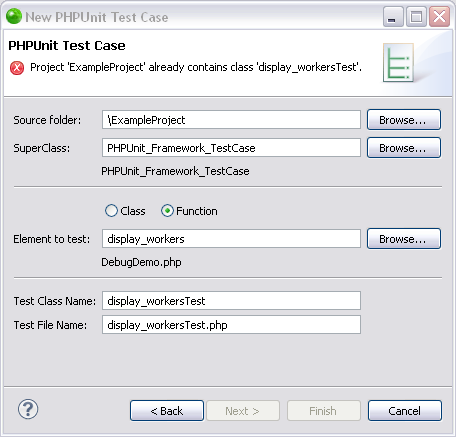Creating a PHPUnit Test Case
This procedure describes how to create a PHP Unit test case.
Zend Studio will
automatically create test case files which can be run in order to check
the functionality of your code.
You must first create a file containing a class with functions which
will be tested when the PHPUnit Test case is run.
|
|
|
|

|
To create a PHPUnit Test Case:
-
In PHP Explorer
view, right-click the file containing the classes you would
like to test and select New
| Other | PHP | PHPUnit | PHPUnit Test Case.
The PHPUnit Test Case dialog will open, with relevant information
already entered into the various fields.
Note that a new file will be created called "FileName"Test.php

New
PHPUnit Test Case dialog
-
A
SuperClass is a class from which the new PHPUnit Test Case
will inherit functionality (e.g. setup and constructors).
If necessary, click Browse
next to the 'SuperClass' field to select a different PHPUnit
Framework SuperClass.
-
Click Browse
next to the 'Element to test' field to select the Class or
Function which will be tested in the new PHPUnit Test Case.
-
If
this is the first PHPUnit Test created for the project, a
warning will appear stating that the PHPUnit is not on the
include path of your project.
To add it to the include path, click the underlined "Click
here" link at the bottom of the dialog screen. This will
enable PHPUnit Content Assist options in the PHPUnit Test.
Once it has been clicked, the link and the warning message
will disappear.
-
Click Finish
to create your test case.
-
The new test file,
containing tests for the selected elements, will be added
to your project.
Note that all relevant functions in the original class will
have a corresponding test function in the test file.
However, test functions will have been created with no parameters.
-
Before you can
run your test file, you must create relevant tests and parameters
for each of your functions, depending on the results you expect
to see when the function is run. For each function, write
a test with demo input parameters and the expected result.
When the test is run, Zend Studio
will insert these parameters into your original file's functions
to see if the result is as expected.
|
|
Once
you have completed the file by creating relevant test functions
and inserting parameters, your PHPUnit test case is ready to be
run.
|
See the Running a PHPUnit Test Case
topic for instructions on how to run your PHPUnit Test Case.



